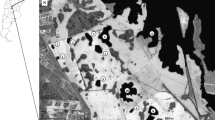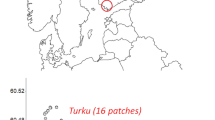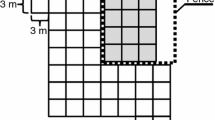Abstract
Herbivores influence the structure of plant communities in arctic-alpine ecosystems. However, little is known of the effect of herbivores on plant colonisation following disturbance, and on its variability depending on the identity of herbivores and the characteristics of the habitats. To quantify the role of large and small vertebrate herbivores, we established exclosures of two different mesh sizes around disturbed subplots in forest and nearby tundra habitats in four contrasting locations in the forest-tundra ecotone in northernmost Sweden and Norway. The study revealed that herbivores influenced the abundance but not the species composition of regenerating vegetation. Gaps were colonised by the dominant species in the surrounding vegetation. The only exception to this expectation was Empetrum nigrum, which failed to colonise gaps even though it dominated undisturbed vegetation. Significant effects of herbivory were only detected when both small and large herbivores were excluded. Herbivores decreased the abundance of three of the most common species Vaccinium myrtillus, Vaccinium vitis idaea, and Deschampsia flexuosa. The effect of herbivory on the abundance of these three species did not differ between habitats and locations. However, the composition of the regenerating vegetation differed between habitats and locations. The disturbance treatment increased the species richness on the scale of plots, habitats, and sites. However, on the scale of whole locations, all species found in disturbed areas were also found in undisturbed areas, suggesting that the natural disturbance regime in arctic landscapes is high enough to sustain colonising species.
Similar content being viewed by others
References
P.B. Adler D.A. Raff W.K. Lauenroth (2001) ArticleTitleThe effect of grazing on the spatial heterogeneity of vegetation Oecologia 128 465–479 Occurrence Handle10.1007/s004420100737
O.W. Archibold (1984) ArticleTitleA comparison of seed reserves in arctic, subarctic, and alpine soils Canadian Field Naturalist 98 337–344
G.O. Batzli S.F. White S.F. MacLean SuffixJr. F.A. Pitelka B.D. Collier (1980) NoChapterTitle J. Brown P.C. Miller L.L. Tieszen F.L. Bunnell (Eds) An Arctic Ecosystem: The Coastal Tundra at Barrow, Alaska Dowden Hutchinson and Ross, Stroudsburg
D.R. Bazely R.L. Jefferies (1985) ArticleTitleGoose faeces: a source of nitrogen for plant growth in a grazed saltmarsh Journal of Applied Ecology 22 693–703
D.R. Bazely R.L. Jefferies (1986) ArticleTitleChanges in the composition standing crop of salt-marsh communities in response to removal of grazer Journal of Ecology 74 693–706
D.R. Bazely R.L. Jefferies (1989) ArticleTitleLesser snow geese and the nitrogen economy of a grazed saltmarsh Journal of Ecology 77 24–34 Occurrence Handle1:CAS:528:DyaL1MXlsFalur8%3D
K.A. Bråthen J. Oksanen (2001) ArticleTitleReindeer reduce biomass of preferred plant species Journal of Vegetation Science 12 473–480
J.R. Brown S. Archer (1988) ArticleTitleWoody plant seed dispersial and gap formation in a North-American sub-tropical savanna woodland – the role of domestic herbivores Vegetatio 73 73–80 Occurrence Handle10.1007/BF00031854
J.M. Bullock B. Clear Hill J. Silvertown M. Sutton (1995) ArticleTitleGap colonization as a source of grassland community change: effects of gap size and grazing on the rate and mode of colonization by different species Oikos 72 273–282
J.C. Chambers (1995) ArticleTitleRelationships between seed fates and seedling establishment in an alpine ecosystem Ecology 76 2124–2133
S.L. Collins S.M. Glenn (1991) ArticleTitleImportance of spatial and temporal dynamics in species in species regional abundance and distribution Ecology 72 654–664
Crawley M.J. 1997. Plant-herbivore dynamics. In: Crawley M.J. (ed.), Plant Ecology. Blackwell, pp. 401–474.
M.J. Crawley (2002) Statistical Computing: An Introduction to Data Analyses Using S-plus John Wiley and Sons Ltd ChichesterUK
G.R. Edwards M.J. Crawley (1999) ArticleTitleHerbivores, seed banks and seedling recruitment in mesic grassland Journal of Ecology 87 423–435 Occurrence Handle10.1046/j.1365-2745.1999.00363.x
B. Freedman N. Bill J. Svoboda G. Henry (1982) ArticleTitleSeed banks and seedling occurrence in a high arctic oasis at Aleksander FjordEllesmere IslandCanada Canadian Journal of Botany 60 2112–2118
B.C. Forbes R.L. Jefferies (1999) ArticleTitleRevegetation of disturbed arctic sites: constraints and applications Biological Conservation 88 15–24 Occurrence Handle10.1016/S0006-3207(98)00095-0
D. Grellmann (2002) ArticleTitlePlant responses to fertilization and exclusion of grazers on an arctic tundra heath Oikos 98 190–204 Occurrence Handle10.1034/j.1600-0706.2002.980202.x
P.J. Grubb (1977) ArticleTitleThe maintenance of species-richness in plant communities: the importance of the regeneration niche Biological Review 52 107–145
D. Hagen (2002) ArticleTitlePropagation of native Arctic and alpine species with a restoration potential Polar Research 21 37–47
T. Hallingbäck I. Holmåsen (1981) Mossor: en fälthandbok Interpublishing AB Stockholm
I. Hanski M. Gyllenberg (1993) ArticleTitleTwo general metapopulation models and the core-satellite species hypothesis American Naturalist 142 17–41 Occurrence Handle10.1086/285527
J.L. Harper (1977) The Population Biology of Plants Academic Press London
P.E. Hulme (1994) ArticleTitleSeedling herbivory in grassland: relative impact of vertebrate and invertebrate herbivores Journal of Ecology 82 873–880
P.E. Hulme (1996a) ArticleTitleHerbivory, plant regeneration and species coexistence Journal of Ecology 84 609–615
P.E. Hulme (1996b) ArticleTitleHerbivores and the performance of grasslands plants: a comparison of arthropodmollusc and rodent herbivory Journal of Ecology 84 43–51
R.L. Jefferies D.R. Klein G.R. Shaver (1994) ArticleTitleVertebrate herbivores and northern plant communities: reciprocal influences and responses Oikos 71 193–206
S. Jonasson (1986) ArticleTitleEvaluation of the point intercept method for the estimation of plant biomass Oikos 52 101–106
S. Jonasson (1992) ArticleTitlePlant responses to fertilization and species removal in tundra related to community structure and clonality Oikos 63 420–429
O. Kalela (1957) ArticleTitleRegulation of reproductive rate in subarctic populations of the vole Clethrionomys rufucanus (Sund.) Ann. Acad. Sci. Fenn., A IV 34 1–60
P.M. Kotanen (1997) ArticleTitleEffects of gap area and shape on recolonization by grassland plants with differing reproductive strategies Canadian Journal of Botany 75 352–361
S.J. McNaughton (1983) ArticleTitleSerengeti grassland ecology: the role of composite environmental factors and contingency in community organization Ecological Monographs 53 291–320
R. Moberg I. Holmåsen (1982) Lavar: En fälthandbok Interpublishing AB Stockholm
J. Moen P.A. Lundberg L. Oksanen (1993) ArticleTitleLemming grazing on snow-bed vegetation during a population peak, northern Norway Arct. Alp. Res. 25 130–135
B. Mossberg L. Stenberg S. Ericsson (1995) Den nordiska floran Wahlström & Widstrand Stockholm
C.P.H. Mulder (1999) ArticleTitleVertebrate herbivores and plants in the Arctic and subarctic: effects on individuals, populations, communities and ecosystems Perspectives in Plant Ecology, Evolution and Systematics 2 29–35
C.P.H. Mulder R.W. Ruess (1998) ArticleTitleEffects of herbivory on arrowgrass: interactions between geeseneighboring plants, and abiotic factors Ecological Monographs 68 275–293
M.-C. Nilsson O. Zackrisson (1992) ArticleTitleInhibitation of Scots pine seedling establishment by Empetrum nigrum Journal of Chemical Ecology 18 1857–1870 Occurrence Handle1:CAS:528:DyaK38XmsVylurg%3D
M.-C. Nilsson (1994) ArticleTitleSeparation of allelopathy and resource competition by the boreal dwarf shrub Empetrum nigrum ssp. hermaphroditum Hagerup Oecologia 98 1–7 Occurrence Handle10.1007/BF00326083
J. Olofsson L. Oksanen (2002) ArticleTitleRole of litter decomposition for the increased primary production in areas heavily grazed by reindeer: a litter bag experiment Oikos 96 507–515 Occurrence Handle10.1034/j.1600-0706.2002.960312.x
J. Olofsson J. Moen L. Oksanen (2002) ArticleTitleEffects of herbivory on competition intensity in two arctic-alpine tundra communities with different productivity Oikos 96 265–272 Occurrence Handle10.1034/j.1600-0706.2002.960208.x
J. Olofsson S. Stark L. Oksanen (2004a) ArticleTitleHerbivore influence on ecosystem processes in the tundra Oikos 105 386–396 Occurrence Handle10.1111/j.0030-1299.2004.13048.x Occurrence Handle1:CAS:528:DC%2BD2cXktVGnu7w%3D
J. Olofsson P.E. Hulme L. Oksanen O. Suominen (2004b) ArticleTitleImportance of large and small mammalian herbivores for the plant community structure in the forest tundra ecotone Oikos 126 324–334 Occurrence Handle10.1111/j.0030-1299.2004.13224.x
J. Olofsson H. Kitti P. Rautiainen S. Stark L. Oksanen (2001) ArticleTitleEffects of summer grazing by reindeer on composition of vegetation, productivity and nitrogen cycling Ecography 24 13–24 Occurrence Handle10.1034/j.1600-0587.2001.240103.x
G.P. Quinn M.J. Keough (2002) Experimental Design and Data Analysis for Biologist Cambridge University Press CambridgeUK
S. Stark D. Grellmann (2002) ArticleTitleSoil microbial responses to herbivory in an arctic tundra heath at two levels of nutrient availability Ecology 83 2736–2744
U. Sommer (2000) ArticleTitleBenthic microalgal diversity enhanced by spatial heterogeneity of grazing Oecologia 122 284–287
B.A. Tihomirov (1959) Vzajmosvjazi Zsivotnogo Mira I Rastitelȁ9nogo Pokrova Tundry – Trudy Akad. Nauk. Bot. Inst. Kormarova Moscow
R. Van der Wal R. Brooker E. Cooper R. Langvatn (2001) ArticleTitleDifferential effects of reindeer on high Arctic lichens Journal of Vegetation Science 12 705–710
R. Van der Wal R.D. Bargett K.A. Harrison A. Stien (2004) ArticleTitleVertebrate herbivores and ecosystem control: cascading effects of faeces on tundra ecosystems Ecography 27 242–252 Occurrence Handle10.1111/j.0906-7590.2004.03688.x
R. Virtanen H. Henttonen K. Laine (1997) ArticleTitleLemming grazing and structure of a snowbed plant community – a long-term experiment at KilpisjärviFinnish Lapland Oikos 79 155–166
D.A. Walker M.D. Walker (1991) ArticleTitleHistory and pattern of disturbance in Alaskan arctic terrestrial ecosystems: a hierarchical approach to analysing landscape change Journal of Applied Ecology 28 244–276
D.A. Wardle O. Zackrisson G. Hörnberg C. Gallet (1997) ArticleTitleThe influence of island area on ecosystem properties Science 277 1296–1299 Occurrence Handle10.1126/science.277.5330.1296 Occurrence Handle1:CAS:528:DyaK2sXlslahuro%3D
P. Welling K. Laine (2001) ArticleTitleRegeneration by seeds in alpine meadow and heath vegetation in subarctic Finland Journal of Vegetation Science 13 217–226
R.J. Williams (1992) ArticleTitleGap dynamics in sub-alpine heathland and grassland vegetation in south-eastern Australia Journal of Ecology 80 343–352
O. Zackrisson M.-C. Nilsson (1992) ArticleTitleAllelopathic effects by Empetrum hermaphroditum on seed germination of two boreal tree species Canandian Journal of Forest Research 22 1210–1219
Author information
Authors and Affiliations
Corresponding author
Rights and permissions
About this article
Cite this article
Olofsson, J., Hulme, P.E., Oksanen, L. et al. Effects of mammalian herbivores on revegetation of disturbed areas in the forest-tundra ecotone in northern Fennoscandia. Landscape Ecol 20, 351–359 (2005). https://doi.org/10.1007/s10980-005-3166-2
Issue Date:
DOI: https://doi.org/10.1007/s10980-005-3166-2




